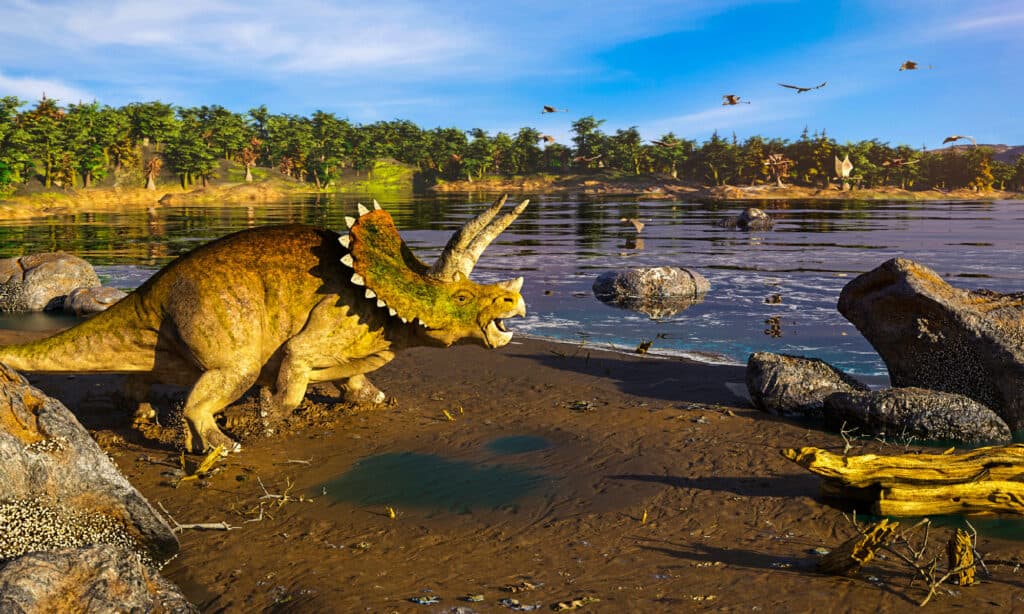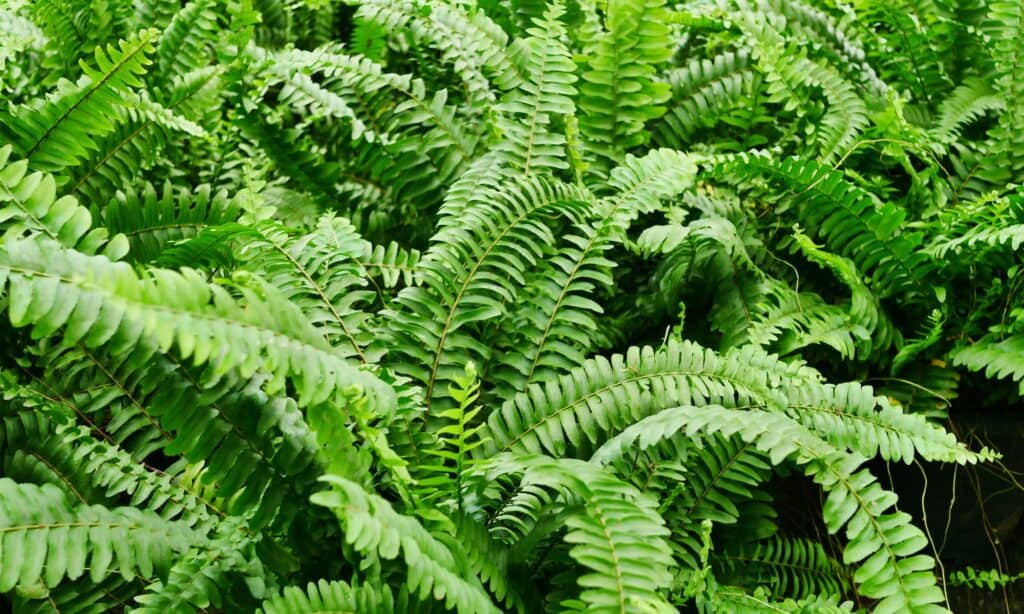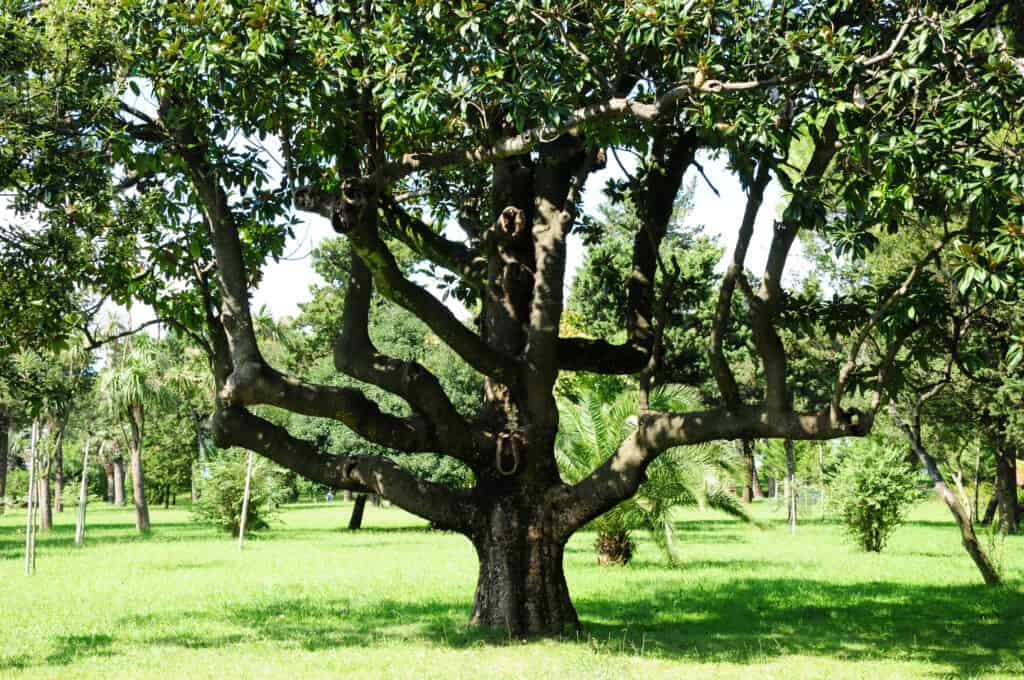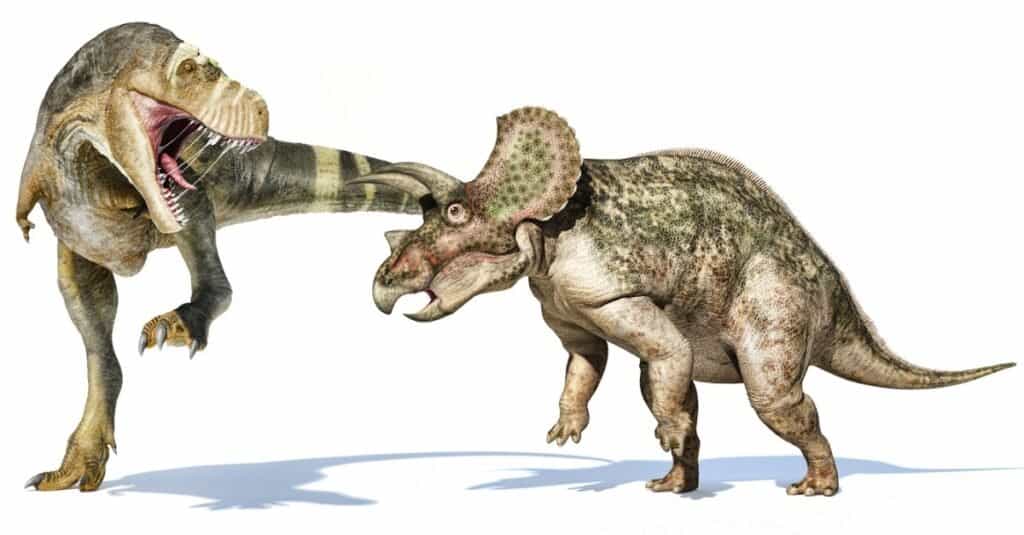There are many kinds of dinosaurs, but one of the best-known and most featured is the Triceratops. They are immediately recognizable thanks to the three horns on top of their heads. Greek is the origin of the word triceratops, according to etymologies. The word tri means three, keras translates to a horn, and ops means face. As a result of combining these root words, a word emerged. Because of this, Triceratops literally means “three-horned face,” a reference to the three horns that can be found on their face. There is one above the eyes and two in the nose area.
What else do you happen to know about this fascinating dinosaur? We’ll explore what the Triceratops ate and other interesting facts about this dinosaur that once roamed the earth.
Quick Overview of the Triceratops

The Triceratops is a three-horned dinosaur that lived during the Cretaceous Period.
©iStock.com/dottedhippo
There are many triceratops fossils found in the uppermost Cretaceous deposits of western North America. Science has discovered specimens of these dinosaurs in Colorado, Montana, Wyoming, South Dakota, and a few Canadian provinces, proving they lived in North America. The dinosaur lived in the Maastrichtian era, which is part of the Cretaceous Period, which lasted from 145 million years ago to 66 million years ago.
There were many different types of dinosaurs, but the Triceratops was one of the largest at the time. According to its measurement, it measured between 26 and 30 feet in length. On average, it would reach a height of 10 feet. In terms of size, the skull of a Triceratops was one of the largest among terrestrial animals.
However, that still does not fully explain how large this animal was. Triceratops was capable of weighing between 6.1 and 12 tons, depending on the individual dinosaur. In addition to its famous three horns, it also had a bone ruff or frill around the back of the head. Their four sturdy legs enabled them to walk with ease. As a result of all these characteristics, it is easy to see how the Triceratops could easily ram another dinosaur due to its powerful body.
Let’s take a look at what the Triceratops ate now that we know just how powerful it was.
What Does a Triceratops Eat?

The Triceratops was a herbivore that would eat a variety of plants.
©Jean-Michel Girard/Shutterstock.com
The Triceratops would eat a diet that consists primarily of leaves. You may be wondering how researchers know what an extinct animal once ate. Well, a dinosaur’s teeth help scientists determine what kind of food it ate. This species of dinosaur have flattened teeth, which are perfect for grinding plant matter. As a result, we know this species was herbivorous. Due to the low position of their heads on their bodies, researchers believe these dinosaurs also ate leaves and vegetation that was low to the ground. However, it has also been noted that these dinosaurs may have been able to use their massive bodies and horns to take down larger trees.
Consequently, they would have been able to eat a more extensive plant-based diet thanks to this feature. The plants they ate may have included palms, ferns, cycads, and other species available at the time. In addition, another interesting fact about Triceratops is the fact that they had large, narrow beaks at the ends of their jaws. As a result, according to the Society for the Study of Evolution, this jaw and beak design was thought to make it easier to grasp and pluck than to bite.
Let’s take a closer look at the types of plants triceratops would eat now that we know what they would eat and how they would eat.
What Type of Plants Did the Triceratops Eat?
The Triceratops did not only have teeth that were good at slicing and plucking plants, but they also had specific body and facial features that made it possible to access higher vegetation. It was believed that Triceratops consumed a variety of plant species. The stomach remains of fibrous plants have been found in their stomach, but it’s hard to tell which plant they came from. However, we do know about the types of plants that were available during the Cretaceous Period. So let’s take a look at the plants that the Triceratops would have most likely eaten:
Maple Trees

Maple trees grow anywhere from 33 feet to 148 feet tall.
©iStock.com/JUN DONG
It is believed that maple trees originated during the Cretaceous Period. The Triceratops had plenty of maples to choose from in North America since there are more than 130 native species. Moreover, maple trees grow anywhere from 33 feet to 148 feet tall. In comparison to a beech or oak tree, a Triceratops would have an easier time reaching some saplings of maple trees than other large trees.
Ferns

Ferns were a popular dish for the hungry Triceratops.
©iStock.com/Supersmario
Ferns were another popular dish for the hungry Triceratops. To this day, we can still find ferns, and they happen to be an incredibly popular houseplant option. A hungry Triceratops would have found it easy to eat the leaves from a fern. This is because they are not tough plants and are pretty easy to bite and chew. This would prove to be a great meal for this dinosaur.
Magnolias

A Triceratops could have taken a bite out of the magnolia tree and enjoyed a nice meal of it.
©Vahan Abrahamyan/Shutterstock.com
During the Cretaceous Period, magnolia flowers were available to the dinosaurs, and thus a passing Triceratops would have been able to eat them as a nice meal. It is common for magnolia flowers to grow on trees. In other words, a Triceratops could have taken a bite out of this tree and enjoyed a nice meal of it.
Conifers
It has been speculated that conifers may have been able to offer dinosaurs a source of food as they bear cones. However, there were some dinosaurs that couldn’t get to them since they were hard to access, and the vegetation was certainly not easy to penetrate. In spite of this, it is possible that the Triceratops could have picked conifers with its beak. There is also speculation that the Triceratops might have been able to eat the needles or cones of a conifer forest due to the wear-resistant teeth it had.
Eudicots
Eudicots were another option that could have been considered as a meal for the Triceratops. These are plant groups that date back to the Cretaceous Period. It is known that the flowers produce dual seed leaves as part of their reproductive process. As a result of the low posture of a Triceratops, it would have been possible for it to eat eudicots easily.
How Did the Triceratops Forage for Food?
Due to the size of the Triceratops, a large amount of food was necessary to sustain them. It wouldn’t be enough to munch on a few leaves here and there. There is still a lot of speculation to this day about how the Triceratops would spend their day.
Triceratops are usually portrayed in movies and television as herding animals, similar to bison and elephants. The reality is that there is no evidence to suggest that this hypothesis is true, or to disprove it. In some cases, fossils were found in groups, but it is unknown whether these fossils belonged to a family or if they belonged to another social group. Since we are only able to examine a small fraction of fossils, we are not able to discover much about their behavior.
However, this hasn’t stopped scientists from speculating about their behavior. Some paleontologists believe that the dinosaurs roamed alone or in small packs through dense forests. The Triceratops would dine on vegetation and lounge in pools, swamps, or mud bogs during the hottest part of the day.
The Triceratops also had a narrow mouth and low-set head. This suggests it had a more specialized diet than its peers, like the Edmontosaurus. As a result of its powerful beak and wide array of teeth, Triceratops was likely to pick and chop trees and other rough plants with their powerful beak and teeth. Each day, hundreds of pounds of tough vegetation, such as cycads, ginkgoes, and conifers, could be picked off with their beaks and eaten.
As we now understand the Triceratops’ foraging habits and how much they ate, let’s explore further. What predators did the Triceratops have out in the wild?
Did the Triceratops Have Any Natural Predators?

The Triceratops would have to watch out for the T. Rex, which was one of its biggest predators.
©iStock.com/leonello
The Triceratops was an incredibly large dinosaur, as we have explained previously. Taking that into account, one might assume that they had no natural predators. However, this is not the case. The Triceratops actually lived during the same time period as the Tyrannosaurus Rex. Despite that, that wasn’t the only major predator that the species had to keep an eye out for either.
Many species of Maniraptoran dinosaurs, such as Novaraptors, Velociraptors, etc., could also hunt the Triceratops. Carnivores such as these moved quickly and used a combination of scavenging and hunting methods. Although the Velociraptor mostly ate smaller creatures, scavenged Triceratopses were occasionally eaten by them. However, for the most part, the Triceratops would mainly have to watch out for the T. Rex.
Was the Triceratops Capable of Defending Itself?
Given the fact that the Triceratops was no small creature, was it capable of defending itself against these predators if they attacked it? The answer to this question is yes. According to researchers, it would seem that the body of these animals was designed to be able to defend themselves if they were threatened.
It is likely that the Triceratops’ head frill was used as a shield to protect its neck while it was foraging for food. The neck frill encircled the back of the neck. It is separated on either side by a portion of the frill. Among the parts of the fossil skull that are the largest are those in its bony frill. It is also interesting to note that Triceratops has the largest skull of any plant-eating dinosaur.
Triceratops were also thought to have used both their horns and frills to defend themselves against predators such as Tyrannosaurus. An older tyrannosaur tooth mark on a Triceratops’ brow horn and neck suggests the Tyrannosaurus did have aggressive head-on encounters with Triceratops. Triceratops usually had a hard time dealing with raptors, regardless of their size, whether they were Dilophosaurus or Velociraptor babies. Maniraptorans would bite at its legs until it crashed to the ground. When it passed out, the raptors would bite and scratch at them. They would do this until it was dead so they could eat it.
However, it is clear that although the Triceratops was a plant-eating animal, it wasn’t just a passive bystander. As a result, they were able to defend themselves actively from predators. They also had the equipment they needed in order to do so.
Up Next:
- Triceratops vs. T-Rex: Who Would Win in a Fight?
- Triceratops vs. Styracosaurus: Who Would Win in a Fight?
- Torosaurus vs. Triceratops: What Are the Differences?
The photo featured at the top of this post is © Dotted Yeti/Shutterstock.com
Thank you for reading! Have some feedback for us? Contact the AZ Animals editorial team.







